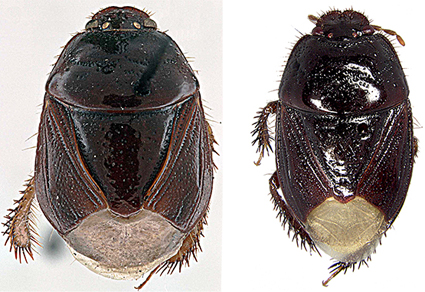Abstract
Cyrtomenus includes seven species arranged in two subgenera and belongs to the most diverse subfamily of burrower bugs, Cydninae. The species present polyphagous habits, and at least two species are considered crop pests. We conduct a phylogenetic analysis based on morphological characters and two weighting schemes to test its monophyly and the validation of the included subgenera, providing for the first time a phylogenetic hypothesis for the genus. Based on the results, a taxonomic review is presented, including redescriptions of the species, identification key, and distribution maps. Monophyly of Cyrtomenus is supported under implied weighting methods (IW), in both analyses, a clade including species of Prolobodes Amyot & Serville is recognized. The species of these two genera share the posterior tibia strongly flattened, a unique feature among Neotropical Cydninae. The subgeneric classification within Cyrtomenus is not corroborated.
References
- Avendaño, J.M., Barão, K.R., Grazia, J. & Schwertner, C.F. (2018) Synonymy of two important crop pests of burrower bugs, Cyrtomenus mirabilis and C. bergi (Hemiptera: Cydnidae), based in a multi-source approach. Zootaxa, 4504 (4), 489–500. https://doi.org/10.11646/zootaxa.4504.4.3
- Becker, M. & Galileo, M.H.M. (1982) A genitália de macho em cinco gêneros neotropicais da subfamilia Cydninae (Heteroptera: Cydnidae). Revista brasileira de biologia, 42, 21–30.
- Bremer, K. (1994) Branch Support and Tree Stability. Cladistics, 10, 295–304. https://doi.org/10.1111/j.1096-0031.1994.tb00179.x
- Dolling, W.R. (1981) A rationalized classification of the Burrower Bugs (Cydnidae). Systematic Entomology, 6, 61–76. https://doi.org/10.1111/j.1365-3113.1981.tb00016.x
- ESRI (2011) ArcGIS Desktop: Release 10. Redlands, CA: Environmental Systems Research Institute.
- Froeschner, R.C. (1960) Cydnidae of the Western Hemisphere. Proceedings of the United States National Museum, 111, 337–680. https://doi.org/10.5479/si.00963801.111-3430.337
- Goloboff, P.A., Farris, J.S., Källersjö, M., Oxelman, B., Ramírez, M.J. & Szumik, C.A. (2003) Improvements to resampling measures of group support. Cladistics, 19 (4), 324–332. https://doi.org/10.1111/j.1096-0031.2003.tb00376.x
- Goloboff, P.A. & Morales, M.E. (2023) TNT version 1.6, with a graphical interface for MacOS and Linux, including new routines in parallel. Cladistics, 39, 144–153. https://doi.org/10.1111/cla.12524
- Grazia, J., Schuh, R.T. & Wheeler, W.C. (2008) Phylogenetic relationships of family groups in Pentatomoidea based on morphology and DNA sequences (Insecta: Heteroptera). Cladistics, 24, 932–976. https://doi.org/10.1111/j.1096-0031.2008.00224.x
- Kment, P. & Vilímová, J. (2010) Thoracic scent efferent system of Pentatomoidea (Hemiptera: Heteroptera) a review of terminology. Zootaxa, 2706 (1), 1–77. https://doi.org/10.11646/zootaxa.2706.1.1
- Lis, J.A. & Heyna, J. (2001) Metathoracic wings venation in Cydnidae (Hemiptera: Heteroptera) and its bearing on the classification of the family. Annales Zoologici, 51, 429–465.
- Lis, J.A. (1999) Burrower bugs of the Old World - a catalogue (Hemiptera: Heteroptera: Cydnidae). Genus, 10, 165–249.
- Lis, J.A. (2000) A revision of the burrower-bug genus Macroscytus Fieber, 1860 (Hemiptera: Heteroptera: Cydnidae). Genus, 11, 359–509.
- Lis, J.A. & Hohol-Kilinkiewicz, A. (2002) Abdominal trichobothrial pattern and its taxonomic and phylogenetic significance in Cydnidae (Hemiptera: Heteroptera). IV. Cydninae. Polish Journal of Entomology, 71, 133–143.
- McDonald, F.J.D. (1966) The genitalia of North American Pentatomoidea (Hemiptera: Heteroptera). Quaestiones Entomologicae, 2, 7–150.
- Maddison, W.P. & Maddison, D.R. (2017) Mesquite: a modular system for evolutionary analysis. Available from: http://mesquiteproject.org (accessed 27 March 2024)
- Melo Molina, E.L., Ortega Ojeda, C.A., Gaigl, A., Ehlers, R.-U. & Bellotti, A.C. (2006) Evaluación de dos cepas comerciales de entomonematodos como agentes de control de Cyrtomenus bergi Froeschner (Hemiptera: Cydnidae). Revista Colombiana de Entomología, 32, 31–38. https://doi.org/10.25100/socolen.v32i1.9355
- Mirande, J. (2009) Weighted parsimony phylogeny of the family Characidae (Teleostei: Characiformes). Cladistics, 25, 574–613. https://doi.org/10.1111/j.1096-0031.2009.00262.x
- Oliveira, L.J. & Malaguido, A.B. (2004) Flutuação e distribuição da população do percevejo castanho da raiz, Scaptocoris castanea Perty (Hemiptera:Cydnidae) no solo em regiões produtoras de soja. Neotropical Entomology, 33, 283–291. https://doi.org/10.1590/S1519-566X2004000300002
- Pluot-Sigwalt, D. & Lis, J.A. (2008) Morphology of the spermatheca in the Cydnidae (Hemiptera: Heteroptera): Bearing of its diversity on classification and phylogeny. European Journal of Entomology, 105, 279–312. https://doi.org/10.14411/eje.2008.038
- Riis, L., Bellotti, A.C. & Arias, B. (2005) Bionomics and population growth statistics of Cyrtomenus bergi (Hemiptera: Cydnidae) on different host plants. The Florida Entomologist, 88, 1–10. https://doi.org/10.1653/0015-4040(2005)088[0001:BAPGSO]2.0.CO;2
- Schaefer, C.W. (1977) Genital capsule of the trichophoran male (Hemiptera: Heteroptera: Geocorisae). International Journal of Insect Morphology and Embryology, 6, 277–301. https://doi.org/10.1016/0020-7322(77)90022-8
- Schuh, R.T. & Slater, J.A. (1995) True Bugs of the World (Hemiptera: Heteroptera): Classification and Natural History. Cornell University Press, Ithaca and London, 336 pp.
- Schwertner, C.F. & Nardi, C. (2015) Burrower Bugs (Cydnidae). In: Panizzi, A.R. & Grazia, J. (Eds.), True Bugs (Heteroptera) of the Neotropics. Entomology in Focus. Springer, Dordrecht, pp. 639–680. https://doi.org/10.1007/978-94-017-9861-7_21
- Sereno, P.C. (2007) Logical basis for morphological characters in phylogenetics. Cladistics, 23, 565–587. https://doi.org/10.1111/j.1096-0031.2007.00161.x


